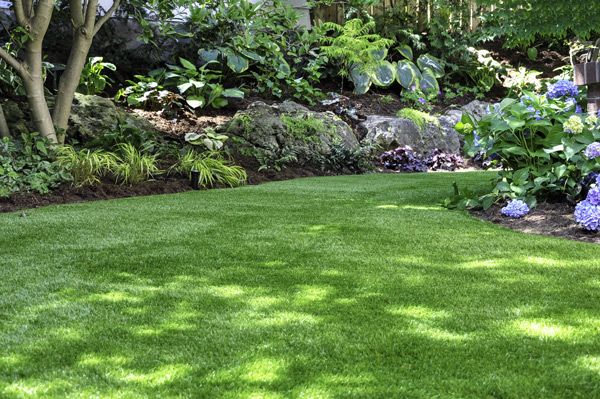Simplify your lawn care routine
Posted on:Jun 13, 2023

Stop overdoing it. A less-is-more approach can be healthier for your lawn.
The days are longer, temperatures warmer and summertime cookouts and outdoor fun are a reminder to keep the lawn in shape. Feeling yard work guilt for not getting a jump on mowing, fertilizing and watering? Don’t let the neighbor’s nonstop toiling make you feel like you haven’t been keepin’ up. Trust us, less can be more. A simplified lawn care routine is better for the grass and buys back much more time to enjoy the season.
Here are some smart-and-simple strategies that encourage a healthy lawn.
Go Long(er)
Overzealous mowing can weaken turf, and vulnerable grass is an invitation for weeds, disease and insects. Let the grass grow a bit. The ideal length for cool-season grasses like Kentucky bluegrass is 3-4 inches, while warm-season varieties like Bermuda grass should be cut at 1-2 inches. Avoid cutting the lawn shorter than the ideal range, thinking you’ll space out mowings. In the end, you’ll likely end up repairing damaged turf.
There is a balance between mowing too soon and waiting too long. You don’t get ahead by cutting grass more often because short blades deliver less energy to roots, causing them to “shrink” rather than developing a deep root system that can access nutrients and moisture from the soil. If you wait too long and cut off more than one-third of the grass blades, your lawn could go into shock.
Be sure your mowers’ cutting height is adjusted so you get the best cut for your grass type. Also, keep mower blades sharpened—usually required after every 8-10 hours of mowing. Clean cuts quicker, while ragged edges from dull blades make a lawn more susceptible to disease.
To Bag, Or Not To Bag?
We are saying to bag the bagger—you don’t have to collect grass clippings as long as you’re mowing at the correct height. You should bag grass clippings if you are collecting dense leaf cover, preventing weed spread, or if the lawn is extremely long. Otherwise, leaving clippings on the lawn is better for the grass. Grass clippings contain valuable nutrients for the lawn and can return up to 25% of its nitrogen needs, reducing the amount of fertilizer required. Again, another time and money savings from a less-is-more approach.
Avoid Overfeeding
Speaking of fertilizer, apply it in moderation and go for slow-release fertilizer that breaks down over time. This allows the turf to absorb the nitrogen, potassium, and phosphorus (N-P-K) rather than stoking fast green-up that can compromise root health. Over-fertilizing promotes green top growth—but the new blades are not as “sturdy” and are easier targets for pests and disease. A minimalist approach to fertilization is to apply a round in the spring once the grass is growing—usually when temperatures are at least 55 degrees Fahrenheit. Plan on another application in early fall, which will provide slow-acting nutrients to keep the lawn healthy through dormancy and into the following spring.
Be Water Wise
During the peak of summer, your lawn generally needs about one inch of water each week. You might be tempted to spread that over several days, watering a little at a time. But, in reality, most of that water would evaporate before it could penetrate the soil, and the little bit that is not lost to evaporation…
Also, “sprinkling” means water is not seeping deep into the soil to reach the roots. Instead, you’re promoting weak top growth, which makes the lawn more vulnerable to disease and weed pressure.
First, determine if your lawn needs watering. Not sure? Simply walk on the lawn; it's in good shape if the grass springs back up. If you can see your footprint’s depressions, grass blades lack the moisture to bounce back.
Signs of over-watering include runoff, grass that feels spongy, and fungus. Thatch buildup also occurs from overwatering because it inhibits organisms from breaking down the plant material. (This prevents oxygen and nutrients from reaching grass roots and invites insects.)
The best strategy is to water deeply and less often. You can test how long to leave sprinklers on by placing a few small containers on the lawn and watering for 15 minutes. Measure the depth of water collected. For example, if you collect one-half inch, you’ll know to water for 30 minutes. If you have an irrigation system, consider getting a smart controller that adjusts watering times based on the weather and your property’s soil conditions.
Maintain A Low-Maintenance Lawn Care Routine
To streamline your lawn care routine and free up more time, stick to a schedule that will keep the grass healthy without overdoing it. Here are some recommendations for the growing seasons. You might need to adjust maintenance based on your region.
Spring
Mow: 3-4 inches for cool-season turf; 1-2 inches for warm-season turf
Lawn care: Apply fertilizer, grub control, and weed control
Summer
Mow: 3-4 inches for cool-season turf; 1-2 inches for warm-season turf
Lawn care: weed control
Fall
Mow: 3 inches for cool-season turf; 1-1 ½ inches for warm-season turf
Lawn care: pre-emergent herbicide, fertilizer, aeration (possible overseeding)
A Lawn You’ll Love—Without The Labor Pains
A relaxed approach to lawn care can be better for your turf, and when you have the right equipment to care for your lawn, mowing is more efficient, comfortable and produces the results you expect.
Check out our library of how-to videos, or sign up for our newsletter. Thinking about a new mower? We can help you choose the best model for your needs.

